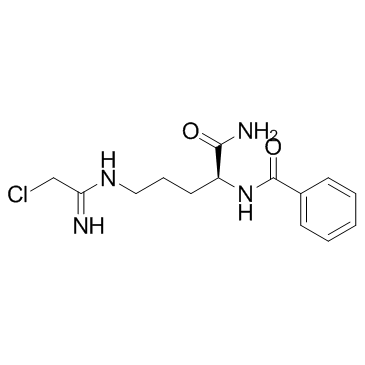| Description |
Cl-amidine is a peptidylarginine deminase (PAD) inhibitor, with an IC50 5.9 μM for PAD4.
|
| Related Catalog |
|
| Target |
IC50: 5.9 μM (PAD4)[1].
|
| In Vitro |
Cl-amidine is a peptidylarginine deminase (PAD) inhibitor, with an IC50 5.9±0.3 μM for PAD4 and Cl-amidine is a bioavailable haloacetamidine-based compound that inhibits all the active PAD isozymes with near equal potency (kinact/KI=13,000 M-1•min-1 for PAD4)[1]. Cl-amidine induces apoptosis (identified as annexin V-positive/propidium iodide-negative cells) in such cells in a dose-dependent manner, indicating that Cl-amidine induces apoptosis of WBCs in vitro. Interestingly, the colon cancer cell line (HT29) is relatively resistant to apoptosis caused by Cl-amidine[2].
|
| In Vivo |
Significantly higher levels of colon inflammation in the 2% DSS than the 2% DSS+Cl-amidine mice are showed. The mean histology scores are 24.2±1.7 (SE) and 13.9±1.6, respectively. Most of the damage in the DSS-only group is in the distal colon, and this damage is suppressed with DSS+Cl-amidine. For the DSS-treated group, the mean colon length is 7.2±0.2 cm. In contrast, the average colon length of the DSS+Cl-amidine group is 8.4±0.2 cm, which is comparable to the mean colon lengths obtained for the wateralone and water+Cl-amidine groups (8.4±0.3 and 7.9±0.2 cm, respectively). The total distance and average speed of mice over a 96-h period are also measured. The results of these analyses demonstrate that the total distance is 5,072±381 and 3,190±401 m for the water-treated and DSS+Cl-amidine mice, but only 800±163 m for the DSS-only group. Similarly, the average speed on the wheel over the 4-day period is 6.2±0.63 and 5.3±0.58 m/min for the water-treated and DSS+Cl-amidine groups, but only 1.8±0.51 m/min for the DSS group. The finding that Cl-amidine improves the speed and distance traveled by the mice is consistent with the histology and colon length data and demonstrates overall improved health, further demonstrating the efficacy of this compound in treating DSS-induced colitis[2].
|
| Cell Assay |
TK6 cells are a lymphoblastoid cell line derived from the spleen >30 years ago. HT29 cells are a colon cancer cell line, with mutant p53. TK6 lymphoblastoid cells and HT29 colon cancer cells are cultured with Cl-amidine in a dose-dependent manner (0, 5, 10, 15, 20, 25, 50 μg/mL) over 24 h. Apoptosis is assessed by annexin V/propidium iodide staining followed by flow cytometry[2].
|
| Animal Admin |
Mice[2] C57BL/6 mice (8-12 wk old) are fed a standard AIN 93M diet. For this DSS mouse model of colitis, mice receive water ad libitum or 2% DSS beginning at day 0 [for oral gavage/treatment experiment or day 7 [for intraperitoneal/prevention experiment. Initial experiments used injections of Cl-amidine (75 mg/kg-1/day-1 ip), beginning concomitantly with the initiation of 2% DSS in the drinking water. This dose is chosen based on results in a RA model that used 100 mg/kg-1/day-1 without overt side effects and without immunosuppressive outcomes. In DSS model, 50 mice in 4 groups are examined, and inflammation scores are recorded[2].
|
| References |
[1]. Yuan Luo, et al. Inhibitors and Inactivators of Protein Arginine Deiminase 4: Functional and Structural Characterization. Biochemistry. 2006 Oct 3; 45(39): 11727–11736. [2]. Chumanevich AA, et al. Suppression of colitis in mice by Cl-amidine: a novel peptidylarginine deiminase inhibitor. Am J Physiol Gastrointest Liver Physiol. 2011 Jun;300(6):G929-38.
|
